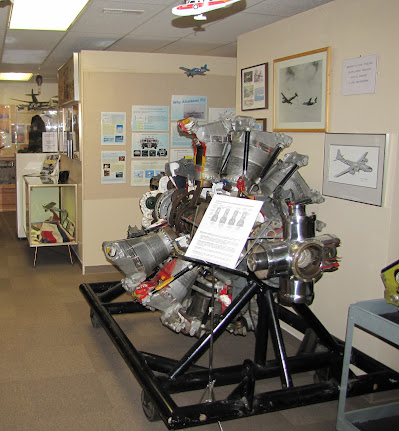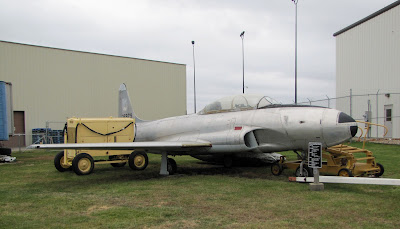 |
| By Carmelo Turdo |

The Aero Experience is a celebration of Midwest Aviation and aerospace achievement. We invite you to join us as we tell the story of Midwest Aviation through first-hand, immersive media presentations. Check in with The Aero Experience frequently to see where we land, and then go out and have your own aero experiences!
Sunday, November 27, 2011
Prairie Aviation Museum in Bloomington, IL Is Must-See Midwest Air Museum
Heritage In Flight Museum Air Park Part of Midwest Museum Tour
 |
| By Carmelo Turdo |
Monday, November 21, 2011
St. Louis Aviation Historian Announces Breakthrough: Aviator and Aeroplane in Old Photograph Identified
 |
| By Jack Abercrombie |
 The dust jacket for James J. Horgan’s City of Flight—The History of Aviation in St. Louis (1984), features a colorized version of an old photograph taken at the St. Louis riverfront. The photograph from which the color version was made is arguably the greatest portrayal of early St. Louis commerce and transportation ever made. In the background, the bridge (designed and built by James Eads--completed in 1874), connecting the mid-west to the eastern part of the country, represents surface travel—the lower deck for a railroad and the upper deck for pedestrians and both horse drawn and motorized vehicular highway travel. The foreground shows a steamship, “St. Louis,” representing a major segment of the trade and travel between north and south. And overhead is an early biplane heading towards the St. Louis shoreline.
The dust jacket for James J. Horgan’s City of Flight—The History of Aviation in St. Louis (1984), features a colorized version of an old photograph taken at the St. Louis riverfront. The photograph from which the color version was made is arguably the greatest portrayal of early St. Louis commerce and transportation ever made. In the background, the bridge (designed and built by James Eads--completed in 1874), connecting the mid-west to the eastern part of the country, represents surface travel—the lower deck for a railroad and the upper deck for pedestrians and both horse drawn and motorized vehicular highway travel. The foreground shows a steamship, “St. Louis,” representing a major segment of the trade and travel between north and south. And overhead is an early biplane heading towards the St. Louis shoreline.Noted aviation historians have observed ever since the book was published that the pictured aeroplane is not the “Red Devil.” Some historians have suggested that the aeroplane configuration more nearly resembles one of the “Little Looper” airframes flown by Lincoln Beachey. But there the matter lay dormant for nearly three decades.
But recently a break-through of sorts occurred. The Greater St. Louis Air & Space Museum received a donation of a large, 20 x 24 inch, photograph identical to that shown in City of Flight. Dr. William R. Green, MD, a professional photographer as well as former physician for McDonnell Aircraft Co., was the donor of the photograph which he acquired during the 1960s from a long closed camera shop in the St. Louis area. Dr. Green, of course, recognized the significance of the image after having observed the glass plate negative from which the enlarged print was made.
The photograph is sufficiently large to show details not heretofore available-details which lead to identification of both the time period as well as the pilot and aeroplane.
The first clue as to the date of the photograph was a sign on the side of the ship which identified the owners of the “St. Louis”—the St. Louis & Tennessee River Packet Co. Since there have been at least a half dozen steamers named “St. Louis,” this total identification was important because this specific boat was not built until 1912—two years after the “Red Devil” flew under the bridge. (The steamer sank in 1918 after being wrecked by a snag a few miles south of St. Louis).
Further research revealed that the glass plate image had been in the archives of the long-defunct (1986) St. Louis Globe-Democrat newspaper. Consequently, a search of Globe-Democrat news articles was warranted, with the focus being on Lincoln Beachey. Knowing that Beachey had toured some 126 cities between May and the end of December 1914, the search was narrowed to that time period.
Thanks to the micro-film newspaper collections of the St. Louis County (MO) Library, it was learned that Lincoln Beachey had, indeed, visited St. Louis during the 1914 tour. On 20 September, he performed at the old Maxwelton Racetrack in St. Louis County, where in addition to performing several aerial stunts, he “raced” against an automobile driven by Barney Oldfield in one of 35 or so staged events in which the team participated around the country.
As previously mentioned, the aeroplane aerodynamic configuration is one of several that Beachey flew during his exhibition days. This particular one is that on display as the original aeroplane in the Hiller Aviation Museum in California. It is the same configuration that a week after his St. Louis visit, Beachey flew over the U.S. Capitol building and the White House on 28 September 1914 (following an intermediate show in Springfield, Illinois).
But there is more to the story—a comparison of the aeroplane in the “over-the-riverfront” image to the “Oldfield Leads” image in the next morning’s newspaper shows that the two aeroplane images are identical! There are several indications that the Globe-Democrat superimposed the aeroplane image from the over-the-riverfront photograph onto the racetrack photo for some unknown reason. You may also notice that the sun is shining from the left of the aircraft and from the right of the car. As a result, the riverfront photographer got no credit for one of the greatest St. Louis aviation historic photographs of all time.
EAA President and CEO Rod Hightower Diverts to St. Louis Downtown Airport Due to High Winds at Wicks Sale Site
 |
| By Carmelo Turdo |
Thursday, November 17, 2011
Members of the AC-119 Gunship Association Are Featured Speakers at MO Aviation Historical Society Meeting
 |
| By Carmelo Turdo |
U.S. Air Force Sgt. Wade Dunn, Gunner on AC-119G Shadow
U.S. Air Force CMSgt Ron Gilbert, Gunner and career NCOU.S. Air Force Captain Ralph LeFarth, Pilot, AC-119G Shadow
 |
| Dr. Larry Fletcher poses with his books and sample gunship ammunition |
Dr. Fletcher spoke about the two models of AC-119s used during the Vietnam War period, all aircraft eventually given to the Republic of Vietnam Air Force to replace the AC-47 Spooky gunships already in use. The AC-119G Shadow carried 8 crew and 4 7.62mm miniguns for anti-personnel operations in defense of friendly bases and in support of friendly troops. The AC-119K Stinger added 2 more crew and two 20mm cannon to the four miniguns for greater anti-armor firepower. It also added a Forward-Looking Infra-Red sensor and 2 J85 jets for added performance. The weapons pointed out of the left side of the aircraft, and the pilot had to keep a left bank angle of about 30 degrees to lay down a cone of fire on the target. Most missions were flown at night, with the "gunners" keeping the weapons operating and the pilot sighting and firing the guns from the cockpit.
 |
| AC-119G Shadow gunship with Lt. Larry Fletcher in photo |
 |
| Dr. Larry Fletcher points out the weapons on the AC-119G |
The aircraft were used by the 71st, 17th and 18th Special Operations Squadrons from 1968-1973. Employing an AC-119 gunship in combat was a lesson in crew coordination. The pilot flew the aircraft, controlling the angle of bank with the yoke wheel and firing the weapons while looking out the left side. The copilot controlled pitch with the yoke column and looked out the right side for anti-aircraft fire from the ground. The copilot actually used a bracket welded to the control yoke rather than the hand wheel so as to not interfere with the pilot's angle of bank inputs. The flight engineer leaned in between the pilots to adjust throttle settings and monitor engine instruments and fuel tank feeds. The "gunners" in the fuselage kept the guns loaded and ready for the pilot to use on command. There were additionally 2-3 navigators and an illumination (flare) operator on both models.
 |
| Sgt. Wade Dunn |
 |
| CMSgt. Ron Gilbert |
 |
| Captain Ralph LeFarth |
 |
| Wade Dunn, Ron Gilbert, Larry Fletcher, Ralph LeFarth, Dan O'Hara, and Everett Sprous |
 |
| Gifts presented to the MO Aviation Historical Society |
The MO Aviation Historical Society would like to thank the members of the AC-119 Gunship Association for speaking at the November meeting in St. Louis. Their story is inspiring, and their service honorable. For more information about the AC-119 Gunship Association, please visit http://www.ac-119gunships.com/.
Wednesday, November 16, 2011
Greater St. Louis Air & Space Museum and Prairie Aviation Museum Team Up to Discuss Growth Strategies
 |
| By Carmelo Turdo |
 |
| Mark Nankivil, Carmelo Turdo, Rudy Frasca and Rick Rehg |
 |
| Representatives from Prairie Aviation Museum with Rudy Frasca |
 |
| Frasca Air Museum entrance |
 |
| Meeting was held at the museum restaurant |
 |
| Aircraft in one of the Frasca Air Museum hangars |
 |
| 1941 Boeing A75N1 Kaydet |
 |
| World War I S.E.5a Replica |
 |
| Bleriot XI Replica |
 |
| 1959 Frasca No. 1 Prototype |
 |
| GAT-1 General Aviation Trainer |
 |
| Frasca Model 122 First Production Electronic Flight System |
 |
| Frasca Model 141 First Production Digital Single-Engine Trainer |
 |
| North American SNJ-6 Texan |
 |
| Spitfire Mk. XVIII and P-40E warbirds |
 |
| David Frasca's Pitts Model 12 |
Subscribe to:
Comments (Atom)


































